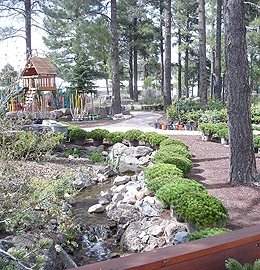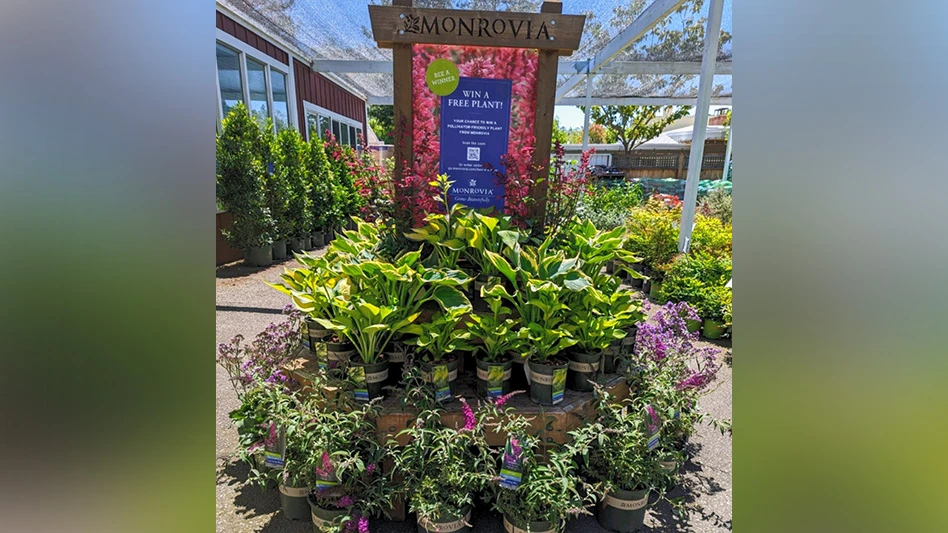
 1. Wyvale in the UK has entire landscape vignettes placed adjacently to inspire ideas. 2. Canadale Nursery in Ontario uses faux house facades to spawn ideas. 3. Bubbling rock options are part of the merchandising mix at Gertens in Minnesota. 4. A tempting walkway meanders through perennial gardens at Platt Hill Nursery in Illinois. 5. A stream and pool area are wrapped into this scene at Warner’s in Arizona. 6. This high-impact Nepeta border at Terrain in Pennsylvania is great inspiration. 7. Gaspers in Pennsylvania shows some effective ways to display hardscape options.The 30-something couple strolling through the garden center with an infant in tow was clearly frustrated. The pair was looking for ways to prevent the new neighbors from staring into their patio every evening when they had dinner outside. Having just spent over $2,000 on furniture, umbrella, lighting and music, they didn’t want to share their evenings with strangers.
1. Wyvale in the UK has entire landscape vignettes placed adjacently to inspire ideas. 2. Canadale Nursery in Ontario uses faux house facades to spawn ideas. 3. Bubbling rock options are part of the merchandising mix at Gertens in Minnesota. 4. A tempting walkway meanders through perennial gardens at Platt Hill Nursery in Illinois. 5. A stream and pool area are wrapped into this scene at Warner’s in Arizona. 6. This high-impact Nepeta border at Terrain in Pennsylvania is great inspiration. 7. Gaspers in Pennsylvania shows some effective ways to display hardscape options.The 30-something couple strolling through the garden center with an infant in tow was clearly frustrated. The pair was looking for ways to prevent the new neighbors from staring into their patio every evening when they had dinner outside. Having just spent over $2,000 on furniture, umbrella, lighting and music, they didn’t want to share their evenings with strangers.
Having drawn a blank at the huge home-improvement store, they had located the garden center by a web search when told by some older friends that this was the best place in town to get ideas and suggestions.
Now they were walking ’round a garden center—which in itself was a new experience—seeing so many plants, colors and shapes, not to mention all those Latin or strange names. Confusion was setting in quickly. Seeing staff members occupied helping other customers, the young husband said, “This is difficult without help; why don’t they put things together so we can get ideas like the furniture stores do? ”
She replied, “I think that ‘discovery learning’ is supposed to be what’s cool about these places, but I’m already on overload!”
And so goes the garden center/landscape dilemma. We have very visual products that require lots of information, but are often displayed like cans of soup.
Separation Anxiety?
“Landscaping” has had an on-off relationship with garden retailing for many years. Initially both disciplines were run by one company on the same site with the same people. Somewhere along the line most owners found that they made more money and had less stress by running the two aspects as separate divisions, often in different locations when land prices made retail property too expensive for a service yard and warehouse.
When new retail nursery companies start up, they usually embrace both disciplines in the early years so as to reach as many consumer dollars as possible. But eventually things tend to separate out. So, in order to have a logical, efficient garden industry company, we keep retail and landscape apart—often to the detriment of the consumer and her money.
Let's End the Obstacle Course
As business from Baby Boomers declines, the next generations see us as just another place to get help with a project. More and more consumers view us in the same light as the kitchen, bathroom or flooring companies they use. If you go to a modern flooring or tile store you see the products used in vignettes to show customers how their bathroom could look including faucets, countertops and appliances; so why not garden centers? Why do we make shopping such an obstacle course with plants lined up like soldiers on parade?
I believe most retail owners under-invest in silent selling because they under-estimate the power of it; concentrating on full service with its relatively high wage bill. Even now when I suggest devoting 0.5 percent of sales every year to silent selling, I get the, “But we explain everything to our customers” pushback.
Laying out the plants as annuals, perennials, shrubs and so on (or worse, alphabetically by botanical name) appeals to employees because it makes it easy to find items and to re-stock when products arrive. For knowledgeable hobbyist customers this was not a big problem. But with the next generation it’s going to be a very big problem unless we retail with ideas and simulations. With a whole new demographic, the conventional garden center is going to have to adapt to remain relevant—or else.
Show the End Result
Visual merchandising can address some of these issues with adjacencies and combination displays of products from several departments, but why not go the full monty with complete landscape-size vignettes? Why not have outdoor rooms, patio, decks, balconies, herb gardens, rose gardens, cutting gardens, play areas, escape areas, exercise areas, deep tranquil shade, hot tropical sun and countless other suggestions?
Why not use some of that retail space (most places have too much anyway, and it just attracts more inventory) as a showroom that can silently sell to browsing customers who may be waiting to be served or, often, who may be too intimidated by a typical garden center to ask a question?
I’m not talking about a few retail employees creating a display on a slow day; I am advocating a professional design and build installation, acting as a silent selling tool and a shop window for the landscape division of the same company. When you do this, just listen to the comments, such as, “I’ve been coming here for years and didn’t even know you had a landscape department.”
Operationally it is difficult to run the two divisions from the same area, but from a marketing- and customer-oriented aspect, it’s ideal to have one place where consumers can see, learn, relate, love, buy and have installed whatever their desires or needs are.
Whether this is done by garden centers leasing or allocating valuable retail space to a landscape division or by landscapers establishing their own showroom in a retail facility, the way forward must surely be to combine both disciplines at the consumer touch-point.
How-To Headquarters
The consumers have to relate what they see to their own home or garden situations, so scale is important, as is clear information. Signage and handouts should answer their questions (“Can we build this under the shade of the next door neighbor’s tree?”) and validate their concerns (“I like the idea of recycled decking material, not virgin timber.”).
The good news is that opportunities are huge. Even in a down economy, surveys indicate that the do-it-for-me market is still alive, not to mention the many small do-it-yourself projects that homeowners are constantly shopping for. Just think how much more business could be out there if garden centers adapted even a small part of the retail space from today’s warehouse concept to a showroom of end-results. Then add a series of information sheets and product lists priced in stages or levels of sophistication. What other home and garden channel is likely to do this? Who else has acres of paid-for land, great traffic flow and a reputation for knowledge and quality? It is yours for the taking!
Contributing editor Ian Baldwin offers other useful ideas in his “TLC … Think Like Customers” sales training program, available at www.ianbaldwin.com.

Explore the August 2010 Issue
Check out more from this issue and find your next story to read.
Latest from Garden Center
- This Florida garden center's busiest days are in the fall, not spring. Find out how they do it
- Terra Nova Nurseries releases new agastache variety, 'Peach Pearl'
- The Certified Shopify Online Garden Center provides local retailers with ecommerce tool
- Meet the All-America Selections AAS winners for 2025
- Endless Summer hydrangeas and Suntory Senetti glam up Grammys red carpet
- Ball Seed releases 2025 edition of 'Thrive and Flourish' for landscape and garden retail
- American Floral Endowment's Fred C. Gloeckner Foundation Research Fund accepting grant proposals
- Floral Marketing Fund and CalFlowers partner to advance floral industry





